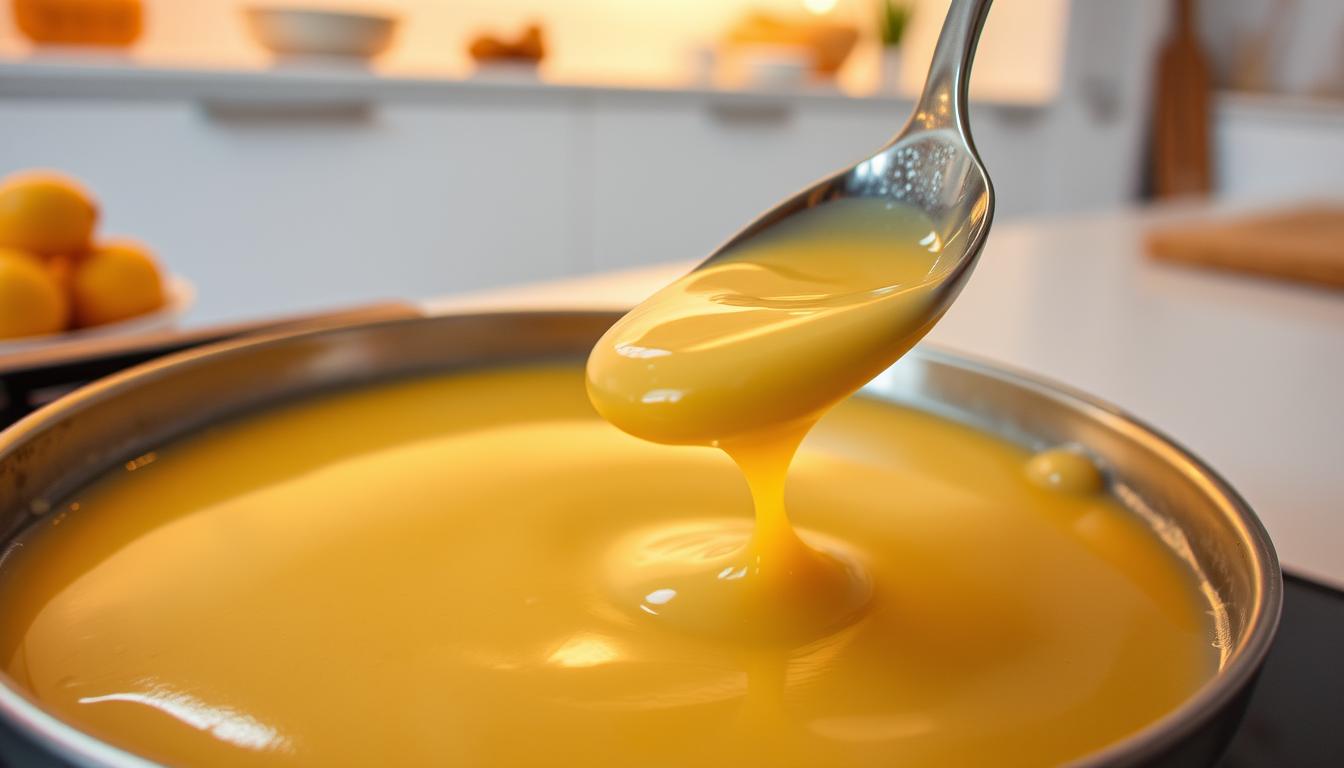Did you know a single egg can transform three cups of liquid into a velvety, restaurant-worthy consistency? This everyday ingredient works like culinary magic, binding flavors while creating textures that turn simple meals into unforgettable experiences.
At the heart of this transformation lies protein coagulation. When heated, egg proteins unwind and reconnect, forming a delicate network that traps liquids. This process occurs in classics like hollandaise and carbonara, where richness defines the dish.
Mastering this technique requires precision. Too much heat scrambles proteins, while too little leaves sauces runny. The sweet spot? Gentle, controlled temperatures that coax proteins into forming silky structures without curdling.
Beyond texture, egg-based methods enhance flavor absorption. Unlike starch-thickened versions, these creations let ingredients shine through cleanly. They’re also versatile—equally at home in breakfast scrambles or elegant dinner presentations.
Key Takeaways
- Protein coagulation creates stable textures through heat-activated bonding
- Temperature control prevents curdling while achieving ideal consistency
- Egg-thickened versions enhance natural flavors better than starch alternatives
- Versatility spans breakfast staples to gourmet preparations
- Proper technique ensures repeatable, professional-grade results
Introduction to Thickening Sauces
The difference between a forgettable meal and a culinary masterpiece often comes down to one element: texture. Our brains register mouthfeel before fully processing flavor, creating instant judgments about quality. A perfectly balanced mixture clings to ingredients without overwhelming them, elevating every bite.

Why Texture Wins Taste Buds
Research shows 32% of diners associate smooth, velvety textures with premium dining experiences. Contrast plays vital roles too—a crisp vegetable gains appeal when paired with creamy dressings. Consistency also affects visual presentation; glossy finishes signal freshness and skill.
Mastering Foundation Methods
Three primary approaches dominate professional kitchens:
| Technique | Best For | Flavor Impact |
|---|---|---|
| Reduction | Wine-based mixtures | Intensifies taste |
| Roux (flour + fat) | Gravies, béchamel | Neutral base |
| Starch slurry | Stir-fries, glazes | Clear finish |
Reduction works by simmering liquid until evaporation concentrates flavors. Starches like cornstarch require cold water mixing to avoid clumping. Each method offers unique advantages, letting you match techniques to specific dishes and desired outcomes.
Understanding these fundamentals prepares you to explore advanced approaches. The right choice transforms ordinary components into cohesive, memorable plates that delight multiple senses simultaneously.
How Eggs Thicken Sauces: The Science of Egg Coagulation
Golden yolks hold culinary magic in their protein-packed structure. When warmed gradually, these liquid gold components create luxurious textures through molecular teamwork. This process works wonders in carbonara sauces and custards alike.

Yolk Proteins: Nature’s Thickening Agents
Rich in lecithin and lipoproteins, yolks bind liquids while adding depth. Their proteins unwind at 144–158°F (62–70°C), forming a stable network that traps moisture. This transformation explains why béarnaise clings perfectly to steak.
Mastering Temperature Control
Tempering protects delicate proteins from sudden shocks. Start by whisking 2 tablespoons of hot liquid into beaten yolks. Repeat twice before combining with the main pot. This gradual approach prevents scrambled textures.
| Method | Texture | Best Uses |
|---|---|---|
| Egg-based | Silky & rich | Custards, emulsified sauces |
| Starch-based | Glossy & neutral | Gravies, fruit fillings |
Stir constantly over low heat until the mixture coats your spoon. Remove from heat before reaching boiling point—proteins tighten further off the burner. For extra safety, use a double boiler.
This technique outperforms flour-thickened versions in flavor clarity. Your hollandaise will carry buttery notes without chalky aftertastes. Perfect for dishes where taste matters as much as texture.
Exploring Alternative Thickening Agents
From French classics to modern gluten-free needs, thickening agents shape sauce success. While some techniques prioritize speed, others build layered flavors through careful preparation. Understanding these options lets you choose the best method for each culinary challenge.

Flour-Based and Roux Methods
The French roux remains the gold standard for rich gravies and creamy béchamel. Combine equal parts melted butter and flour by weight, cooking until nutty aromas emerge. This process eliminates raw flour taste while developing complex flavors.
Three stages offer versatility:
– White roux (2 minutes): Ideal for milk-based sauces
– Blonde roux (5 minutes): Perfect for velouté
– Brown roux (10 minutes): Adds depth to gumbo
| Thickener | Thickening Power | Sauce Clarity | Common Uses |
|---|---|---|---|
| Flour (roux) | Medium | Opaque | Gravies, cheese sauces |
| Cornstarch | High | Translucent | Stir-fries, fruit glazes |
| Arrowroot | High | Clear | Dairy-free sauces |
Gluten-Free Options: Cornstarch and Arrowroot
Mix one tablespoon cornstarch with equal parts cold water before adding to hot liquid. This prevents clumping while creating glossy finishes. Arrowroot works similarly but requires lower heat to maintain effectiveness.
Both alternatives thicken faster than flour-based methods. They’re ideal for last-minute adjustments or delicate flavors you don’t want to mask. Always add slurries gradually—you can always thicken more, but thinning proves trickier.
Expert Tips for Achieving the Perfect Sauce Consistency
Great sauces balance science and intuition. Master these techniques to create textures that elevate dishes from good to extraordinary.
Timing, Temperature, and Reducing Techniques
Reduction transforms watery mixtures into flavor-packed masterpieces. Simmer tomato-based or wine-infused creations over medium heat until they coat your spoon. Avoid this method with soy-based blends—salt concentrates dangerously during evaporation.
Use these checkpoints for precision:
– Stir constantly during the first 5 minutes of thickening
– Remove from burner at 185°F (85°C) for egg-based versions
– Add cold butter cubes only after turning off the stove
Practical Advice for Adjusting Liquid to Egg Ratios
Start with 1 yolk per ¾ cup liquid for custard-like thickness. For pan sauces, whisk tempered yolks into reduced drippings gradually. Remember: “You can always add, but you can’t remove” applies to both ingredients and heat.
| Consistency Goal | Egg Yolks | Liquid |
|---|---|---|
| Light coating | 1 | 1 cup |
| Velvety texture | 2 | 1.5 cups |
| Rich custard | 3 | 2 cups |
Rescue thin mixtures with a cornstarch slurry (1:2 ratio). For over-salted creations, add dairy or acid to balance flavors. Your spoon test never lies—properly thickened sauces leave clean trails when drawn across surfaces.
Conclusion
Mastering sauce textures unlocks new dimensions in everyday cooking. This guide reveals how protein behavior transforms basic ingredients into luxurious finishes for any dish. With practice, you’ll wield heat and timing like professional chefs.
Remember: gradual temperature control remains vital. It protects delicate structures while building stability. Understanding these principles lets you adapt techniques across cuisines confidently.
Your newfound skills extend beyond recipes. They form a foundation for experimenting with flavors and textures. Start with classic preparations, then innovate using these science-backed methods.
Keep this guide handy as you explore. Each successful creation boosts kitchen confidence and refines your personal method. Soon, you’ll craft restaurant-quality results that make every meal memorable.



